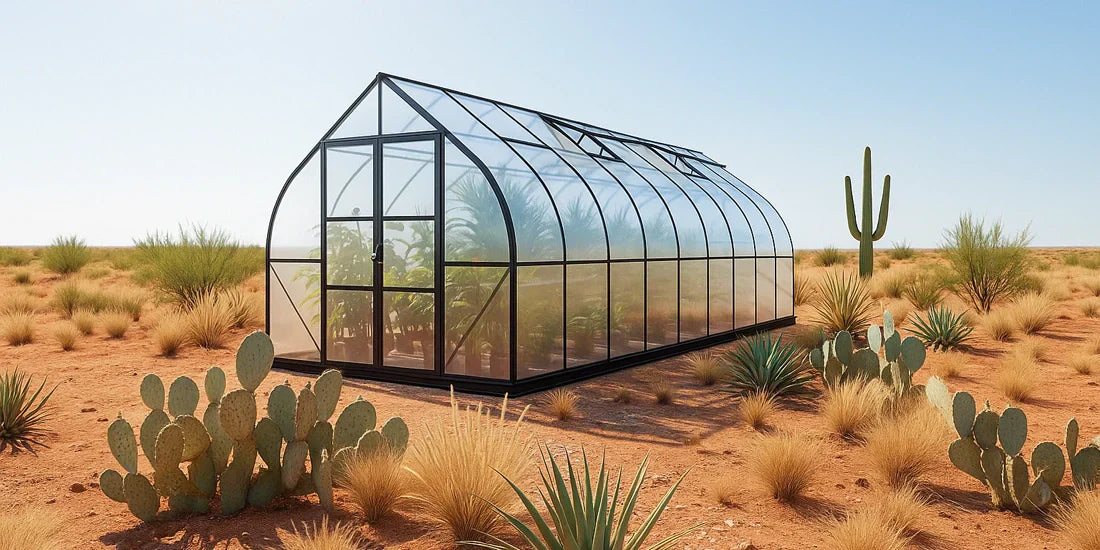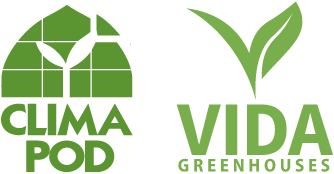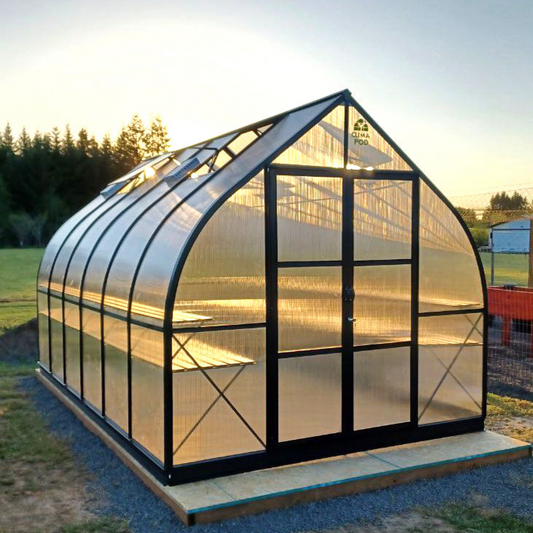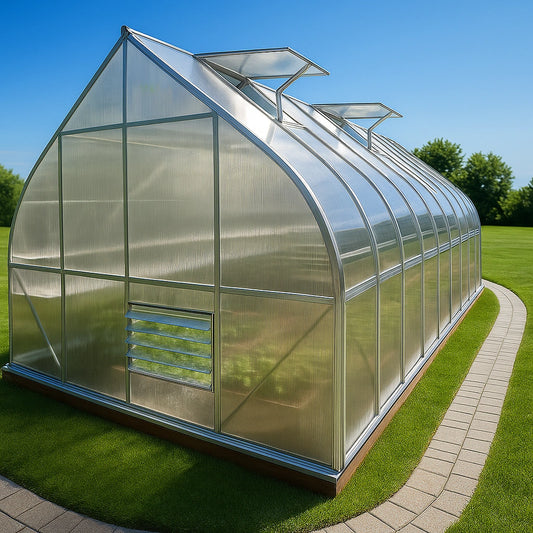
Greenhouses for Hot Climates
Greenhouses for Hot Climates — A Complete Guide
Installing a greenhouse in a hot climate is not about trapping heat — it’s about controlling it. At ClimaPod Greenhouses we help gardeners and small-scale growers turn extreme sun and high temperatures into predictable, productive growing conditions. This guide walks you through the challenges, designs and systems that work best in hot U.S. states like Arizona, Texas, Nevada, New Mexico, Southern California and Florida.
Challenges of Hot Climates
Hot climates amplify several stress factors for both plants and greenhouse structures:
- Excessive air and soil temperatures that can shut down photosynthesis and ripen crops too fast.
- High evaporative demand that dries soil and stresses roots and foliage.
- Intense solar radiation causing leaf scorch, sunburned fruit and rapid water loss.
- UV degradation of low-quality plastics or untreated structural elements.
Design Principles for Hot-Climate Greenhouses
Successful hot-climate greenhouses follow a few overriding design principles: maximize airflow, minimize direct midday radiation on vulnerable plants, and provide effective, water-wise cooling. These principles are the backbone of every Climapod solution.
Site selection & orientation
Place the greenhouse where it benefits from prevailing breezes but also has afternoon shading options. In much of the Southwest (Arizona, Nevada, New Mexico) orient long axis east–west to reduce the surface area exposed to low-angle winter sun and to control afternoon heat. In humid southern states like Florida or Louisiana, position to capture gentle sea breezes where available and avoid heat radiating off paved surfaces.
Footprint & layout
Use a compact footprint with multiple side vents, a tall ridge for stack ventilation, and an access path that doubles as an airflow corridor. Raised beds, gravel paths and shaded work areas reduce radiant heat buildup inside the structure.

Ventilation & Airflow
Ventilation is the single most important system in hot climates. Combine passive and active strategies:
- Roof vents + operable sidewalls: stack effect pulls hot air up and out.
- Cross-ventilation: opposing openings create a constant breeze through the benching area.
- Circulation fans: prevent hot pockets and even out temperature and humidity.
- Automatic vent openers: save labor and react immediately to internal heat spikes.
Shading Strategies
You need flexible shading that can be increased in peak summer and relaxed in spring/fall:
- External shade cloth (30–70% density depending on crop) reduces incoming radiation before it heats the glazing.
- Internal shade curtains are useful for night protection and selective shade for tender seedlings.
- Reflective whitewash or cool roof films on the external surface lower peak temperatures without reducing daylength.
Active & Passive Cooling
Use layered cooling — passive first, active as needed:
Passive cooling
- Thermal mass: water barrels or stone beds absorb daytime heat and release it slowly at night.
- Evaporative cooling via wet walls: highly effective in dry climates (Arizona, New Mexico, Nevada).
- Natural shading: deciduous windbreaks and pergolas that shade in summer and let light in winter.
Active cooling
- Misting systems: lower leaf temperature quickly but increase humidity — best used in conjunction with strong ventilation.
- Evaporative coolers (swamp coolers): efficient where outside air is dry (interior Texas, desert regions).
- Mechanical HVAC: in commercial or high-value operations where precise control is required (often used in Florida’s humid heat).
Materials & Coverings
Choose materials engineered for UV exposure and thermal control:
- Multiwall polycarbonate with UV-stabilized layers — excellent insulation and diffused light.
- Aluminum frames resist corrosion; treat any wooden elements for UV and moisture.
Water Management
Water is the lifeline in hot-climate greenhouses. Focus on conservation and consistency:
- Drip irrigation minimizes evaporation and delivers water directly to root zones.
- Smart controllers and soil moisture sensors avoid over- or under-watering during heat waves.
- Rainwater harvesting with filtered storage provides a free source and reduces dependence on municipal supply.
- Mulch and ground cover inside beds lower evaporation and stabilize soil temperatures.

Best Plants for Hot Greenhouses
Many warm-season crops thrive under controlled heat:
- Heat-loving vegetables: tomatoes, peppers, eggplants, okra.
- Heat-tolerant herbs: basil, rosemary, thyme (with careful watering).
- Specialty crops: chili varieties, citrus seedlings (in protected microclimates), and melons if adequate ventilation is available.
Regional Notes — Practical Advice by State & Zone
Hot climates vary across the U.S.; here are concise tips for key states:
Arizona & New Mexico
Extremely dry heat — evaporative cooling and shade cloth are highly effective. Position greenhouses to catch late afternoon breezes when possible; use thermal mass to moderate night swings.
Nevada
Desert sun with cool nights — combine high ventilation with thermal mass and morning irrigation cycles to minimize mid-day stress.
Texas (South & Central)
Diverse — West Texas is arid (use evaporative cooling); Gulf Coast areas are humid (prioritize dehumidification, strong airflow and disease prevention).
https://climapodgreenhouses.com/pages/buy-greenhouse-in-texas
Southern California
Intense sun with mild winters — diffuse light is valuable here; external shade cloth and reflective coatings reduce crop stress while preserving daylight.
Florida, Louisiana & the Gulf Coast
Hot and humid — evaporation alone can raise humidity to damaging levels. Focus on constant, high-volume ventilation, disease management, and selective dehumidification. Use materials rated for salt air near coastal zones.
Practical Tips & Common Mistakes
- Don’t enclose the greenhouse tightly in summer — lack of air exchange kills crops faster than heat alone.
- Don’t rely on shade alone — shade reduces light but not the need to manage humidity and airflow.
- Plan for maintenance: UV-exposed plastics and seals degrade; keep spare film and service the ventilation motors seasonally.
- Use layered strategies: combining shade, ventilation and cooling is far more effective than any single fix.
Conclusion
A greenhouse in a hot climate is an opportunity: with the right orientation, materials, shading and water-wise cooling, you can grow robust crops year-round where open-field gardening would fail. At Climapod Greenhouses we design modular, field-tested solutions tailored for heat — from the deserts of Arizona to the humid Gulf Coast of Florida. Start small, monitor closely, and scale the systems that work for your microclimate.
Quick Reference Table
| Factor | Recommendation |
|---|---|
| Orientation | East–West axis, add afternoon shade |
| Ventilation | Roof vents, side vents, circulation fans, automatic openers |
| Cooling | Evaporative coolers (dry areas), misting + strong ventilation, thermal mass |
| Shading | External shade cloth 30–70% + internal curtains |
| Covering | UV-stabilized multiwall polycarbonate or reflective greenhouse film |
| Irrigation | Drip systems, moisture sensors, morning irrigation cycles |
| Top crops | Peppers, tomatoes, eggplant, okra, heat-tolerant herbs |
Need help choosing the right Climapod model for your heat zone? Contact our specialists for a free site evaluation and a tailored cooling plan.











